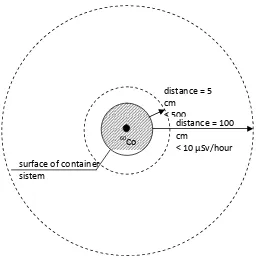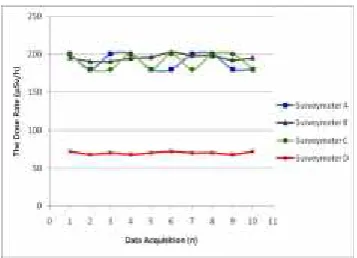Study on the Differences in Measurement Results of Radiation Dose Rate From Cirus
Teletherapy System with
60Co Source in Off Condition Using 4 Different Surveymeters
Wijono and Gatot Wurdiyanto
Center for Technology of Radiation Safety and Metrology, National Nuclear Energy Agency of Indonesia, Jalan Lebak Bulus Raya No. 49, Kotak Pos 7043 JKSKL, Jakarta 12070, E-mail : johnrida @batan.go.id
Abstract.Study on the differences in measurement results of radiation dose rate from Cirus Teletherapy system with60Co source in off condition using 4 different surveymeters have been carried out. This study was conducted to determine the feasibility of performance, measurement of uncertainty and the uniformity of measurement results of 4 different types of surveymeter. The instruments used to measure gamma radiation dose rate has calibration factors ranging from 0.923 to 1.010. Two surveymeters (A and B) have a measurement unit in Sievert/hour (Sv/h) and two others (C and D) has a measurement unit in Rontgen/hour (R/h). Cirus teletherapy system used as research objects have radiation source of60Co with activity of 233.63 TBq as of June 1, 1999. Retrieval of research data was conducted during the system was in off conditions and focused on one point in the front of the container that has the highest gamma radiation dose rate. Data were collected at a distance of 5 cm and 100 cm from the surface of the container front and repeated for 10 times for each measurement point. The results showed that all surveymeters have response and nearly has the same performance. The background was ranged from 0.000 to 0.231 μSv/h. The uncertainty at a distance of 5 and 100 cm was at a ranges (1.93 to 5.55)% and (1.00 to 10.39)%, respectively. The surveymeter B has the best precision because it has advantages 2 decimal digits behind the comma for the same amount of dose rate. Whereas Surveymeter D shows the differences in the measurement at the distance of 100 cm to 5 cm by 63% compared to other three surveymeters (<2%), so the performance and uniformity of these surveymeters were not good. From these results we are expecting that radiation workers should choose one type of surveymeter with the most appropriate and suitable so that the calculation of the limitation of radiation doses for workers/general public can be done properly in accordance with regulation in Perka BAPETEN No. 6/2009 and No. 4/2013.
Keywords: surveymeter, calibration factor, dose rate, Cirus Teletherapy.
Introduction
The implementation of radiation protection and safety system in exploiting the nuclear power is very important thing. To support this case it is necessary to assess the uncertainty of performance measurement in the form of radiation exposure using Surveymeter that has many types. It is also urgent to know the performance of Surveymeter mainly the radiation dose rate measurements of Cirus Teletherapy System with
60Co sources and then proficiency testing should be
conducted with 4 Surveymeter of different type. The purpose of this research was to determine the feasibility of performance, measurement uncertainty and the uniformity of the measurement results of 4 Surveymeter which have different types. Therefore it is necessary to determine the safety status of work area radiation for radiation workers and non-radiation workers (people) according to Regulation of Nuclear Energy Regulatory Agency (BAPETEN) Head No. 4 of 2013 that concerning radiation protection and safety in utilization of nuclear energy (Perka BAPETEN, 2013).
In this paper we have done on the study of differences in measurement results of radiation dose rate from Cirus teletherapy system with60Co source in
off condition using 4 different surveymeters. Several measuring devices the gamma radiation dose rate has calibration factors ranging from 0.923 to 1.010. Conditions of radiation calibration of measuring
2006). Measurement of radiation dose rate is focused on one point in the front of the container that has the highest gamma radiation dose rate.
From the research it is expected to improve radiation safety assurance for radiation workers and non-radiation workers (general public) as stipulated in the nuclear rules and regulations.
Materials and Methods
This research was conducted to determine the feasibility of performance, measurement of uncertainty and the uniformity of the measurement results of 4 Surveymeter (A, B, C and D) that has different type. The instruments of the gamma radiation dose rate used has calibration factors ranging from 0.921 to 1.010. The unit of measurement was in Sievert/hour and Rontgen/h and in conditions calibrated in the Laboratory of PTKMR-BATAN as shown in Table 1.
Table 1. Calibration factor of 4 Surveymeter with different types
Description : measurement date 13 August 2015
Figure 1.The measurement points on the surface of the container system
Surveymeter Scale of measurement Calibration Factor Calibration Date
A Sievert/hour 1.000 14 April 2015
B Sievert/hour 0.995 17 April 2015
C Rontgen/hour 1.010 14 April 2015
D Rontgen/hour 0.921 10 September 2014
Gamma Radiation
Source (60Co)
Gamma Cirus
Teletherapy System
60
Co
distance = 5 cm
< 500
µSv/hourdistance = 100 cm
< 10 µSv/hour
Cirus Teletherapy system used as the research object has a 60Co radiation source with activity of
233.63 TBq as of 1 June 1999. Data of research are taken when the system was in off condition and focused on one point in front of the container that has the highest gamma radiation dose rate. The research process was started with the background counting data retrieval outside teletherapy Cirus system. Then the retrieval of data samples was taken at a distance of 5 cm and 100 cm from the surface of the container face (Figure 2). Retrieval of the background and sample counting data was carried out by repeating up to 10 times for each measurement point.
Uncertainty of type A was determined from measurement acquisition using 4 Surveymeter at a distance of 5 and 100 cm. While the uncertainty of type B was determined from the calibration certificate, the resolution and half-life of60Co. Uncertainty values
of calibration certificates taken appropriate range/scale of measurement used in each surveymeter. The half-life uncertainty of 60Co was determined from TdeR,
1998 Laboratoire National INEEL/R. G. Helmer-LNHB LNE/CEA (Schrader, 2004).
Results and Discussion
Results showed that four surveymeter (A, B, C and D) that has a different type showed a normal response when used for background measurements and samples dose rate counting. Surveymeter have 2 scales of measurement, that is in micro Sievert/hour
and milli Roentgen/hour, so there is a difference resolution of 10-fold between two types of these measuring instruments (10 μSv/h = 1 m/hr).
The performance of each measuring instrument showed good results in measuring of the background counting of dose rate. Of four measuring instruments it can be seen that Surveymeter B has a reading resolution of the most subtle compared to other measuring equipment (Figure 3). While three other measuring equipment has a resolution similar readings with range from 0 to 0.2 μSv/h. While experiencing uniformity measurement accuracy unless Surveymeter D results that differ by more than 100% as shown in Figure 4. These results obtained only in distance measurement of 5 cm. From the results of these images it can also be seen that the container in the form of a shielding system60Co Cirus Teletherapy that
made from combination of Pb and iron manufactured by BATAN has a very good absorbtion for the measurement result and only 40% of the recommended minimum limit according Perka BAPETEN No. 6/2009.
Figure 5 showing the measurement at a distance of 1 m own uniformity results. But the response and character of radiation detectors at Surveymeter D system is different or damaged and must be done recalibration given the longest calibration interval (Table 1). This was done in accordance with the Rule Head of Nuclear Energy Regulatory Agency No. 1 Year 2006 on Dosimetry Laboratory, Calibrate Measure Radiation and Source output Radiation Therapy and Radionuclide Standardization.
Figure 3. Comparison of background dose rate measured by 4 surveymeters.
Uncertainty of measuring at a distance of 5 and 100 cm was in range of (1.93 to 5.55) % and (1.00 to 10.39) %, respectively. Surveymeter B has the best precision of measurement because of advantages 2 decimal digits behind the decimal point to the same amount of dose rate and has the units of measurement in μSv/h. With this condition Surveymeter B has a resolution 10 times better than other Surveymeter which has units of mR/hr. While Surveymeter D shows the result of differences in the measurement of the distance of 100 cm to 5 cm by 63% compared to other three Surveymeters (less than 2%), so the performance and uniformity Surveymeter measuring results is not so good or the detector response that is not normal.
Type B components of uncertainty in the calibration certificate obtained from a calibration
laboratory has been qualified and in accordance with nuclear regulations in force. While the type B uncertainty component of half-life of60Co determined from TdeR 1998 Laboratoire National INEEL/R. G. Helmer-LNHB LNE/CEA obtained 0.015%.
The research results is known surveymeter A, B and C have a feasibility level of performance, uncertainty measuring and the uniformity of the measuring results are uneven. But for Surveymeter D shows the measuring results are relatively different, especially for distance variation measuring from 100 cm to 5 cm. It shows the measuring precision measuring devices are less well (Figure 3). While the level of accuracy, repeatability and measurement resolution of 4 Surveymeter have equal results (Tables 2 and 3).
Figure 5. Comparation of measuring data acquisition fluctuations of dose rate distance of 100 cm on Cirus teletherapy system with60Co source off condition.
Table 2. Components of the radiation dose rate measuring uncertainty within 5 cm on Cirus teletherapy system using the60Co source off condition.
Table 3. Components of the radiation dose rate measuring uncertainty within 100 cm on Cirus teletherapy system using the60Co source off condition
Surveymeter
Tipe A Measuring
(%)
Tipe B Calibration
Certificate (%)
Tipe B Resolution
(%)
Tipe B Half-life
(%)
A 5.55 5.6 0.051 0.015
B 1.93 5.2 0.000 0.015
C 5.55 5.5 0.056 0.015
D 2.33 5.8 1.429 0.015
Table 4. The uncertainty of combined and expanded of dose rate measuring on Cirus teletherapy using the60Co source off condition
With the change of the distance measuring from 100 cm to 5 cm showed the combined and expanded uncertainty of the measurement results relative increase (Table 4). It showed a response rate of all types Surveymeter detectors have similar characteristics. The closer the detector efficiency against gamma radiation decreases thereby increasing the chances of the emergence of the possibility of error measuring caused by radiation scattering factor.
Conclusion
The research results showed that Surveymeter measured in scale of Sv/h with accuracy, precision, repeatability and resolution was better than Surveymeter measured in scale of R/h, especially for instrument that already used in the digital system. It is expected radiation workers can choose one type of surveymeter that most appropriate and according to the type of radiation being measured, so that the calculation of the dose limitation for radiation workers/general public can be done properly in accordance with Perka BAPETEN No. 6/2009 and No. 4/2013.
Acknowledgments
Authors thankful to Research Group of Radiation Metrology Division, the Center for Technology of Radiation Safety and Metrology BATAN for their collaboration during this study.
References
Peraturan Kepala Badan Pengawas Tenaga Nuklir, (2013), tentang Proteksi dan Keselamatan Radiasi dalam Pemanfaatan Tenaga Nuklir, No. 4.
Peraturan Kepala Badan Pengawas Tenaga Nuklir, (2006), tentang Laboratorium Dosimetri, Kalibrasi Alat Ukur Radiasi, dan Keluaran Sumber Radiasi Terapi dan Standardisasi Radionuklida, No. 1.
Schrader, H., Švec, A, (2004), Comparison of ionization chamber efficiencies for activity measurements, Appl. Radiat. Isot. 60, 369-378.
Schrader, H., Kossert, K., Mintcheva, J., (2008), Calibration of a radionuclide calibrator system as a Bulgarian standard for activity, Appl. Radiat. Isot. 66, 965-971.
TdeR., 1998 Laboratoire National INEEL/R. G. Helmer LNE–LNHB/CEA, Table de Radio-nuclides, Recommended Data/Table, Atomic and Nuclear Data. http://www.nucleide.org/DDEP_ a distance of 100 cm


